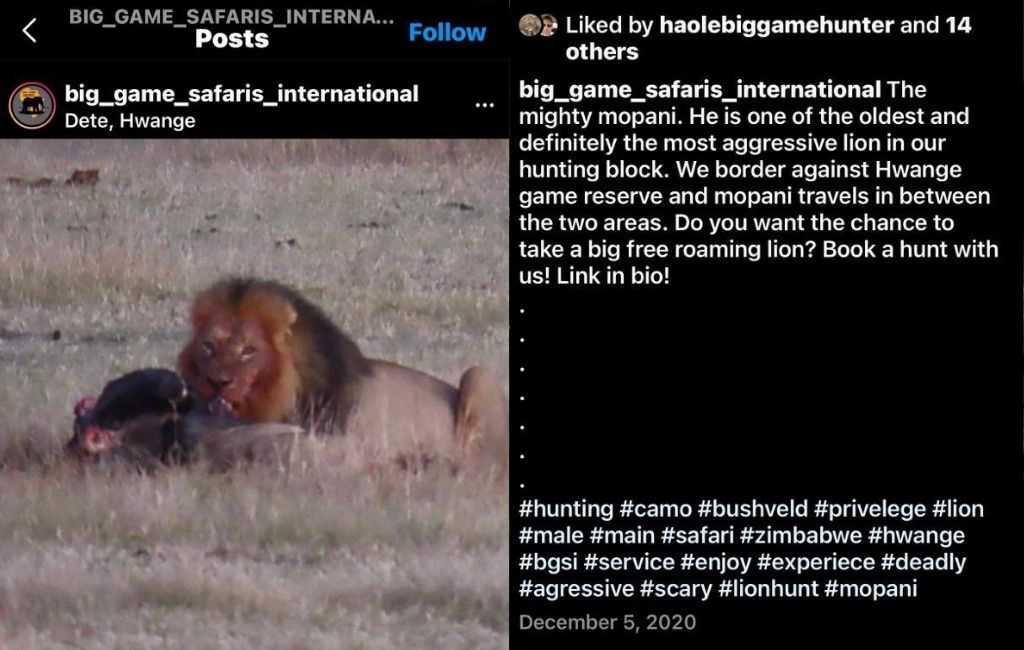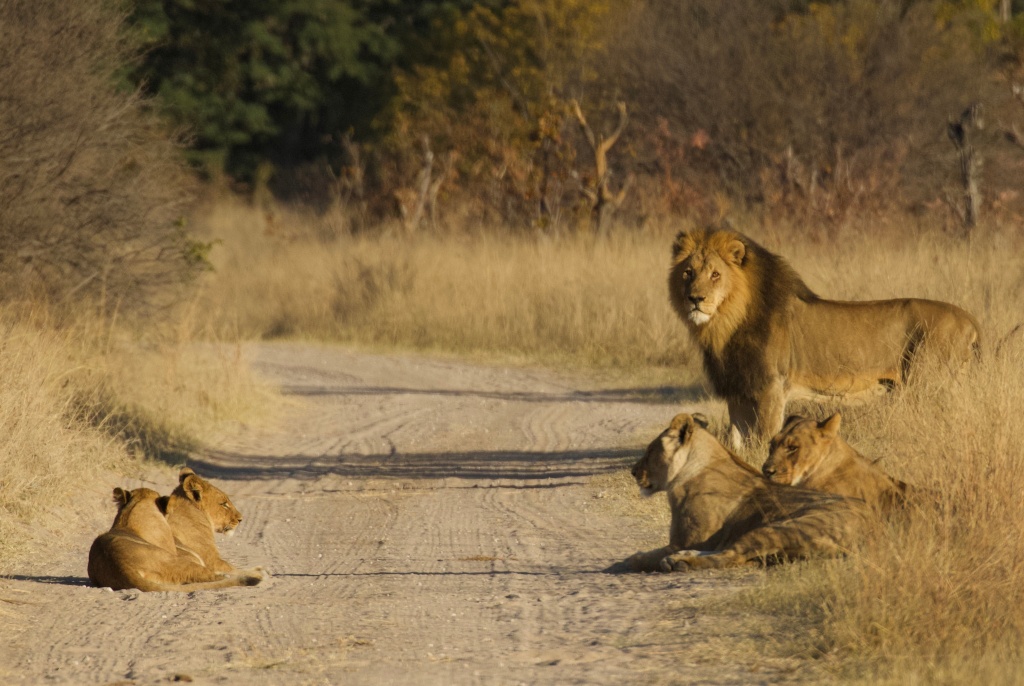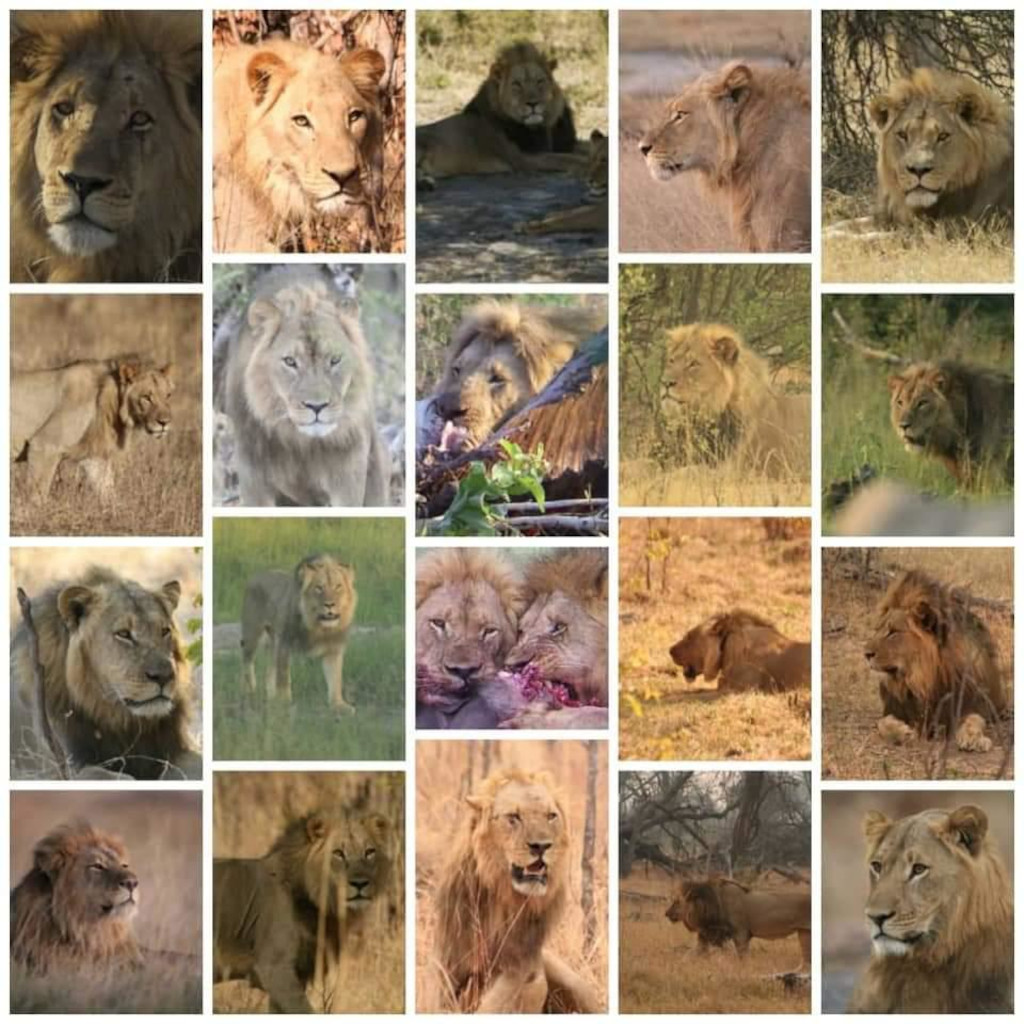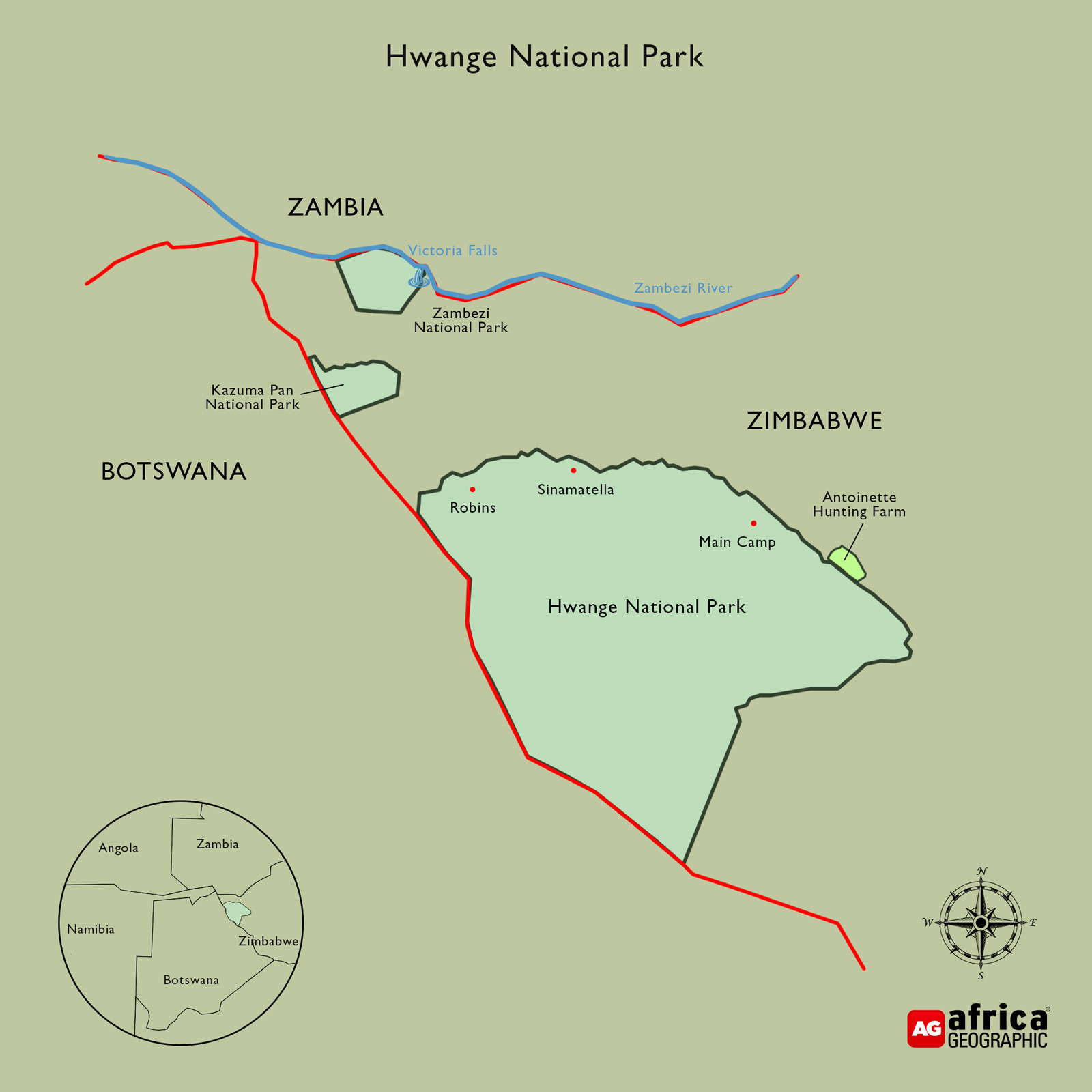
A lion called Mopane was shot by a bowhunter on 5 August 2021 on a hunting concession bordering the unfenced Hwange National Park in Zimbabwe. He was 12 years old and a breeding pride male.
What we know about the hunters:
Information extracted from a Tweet by LionExpose! and confirmed via reliable sources:
- The trophy hunter who killed Mopane is Phillip Smith of Columbia, Missouri, United States.
- The professional hunter accompanying the hunt was Dennis Nyakane, working for Chattaronga Safaris – a South African hunting operator/agent. Nyakane is listed as ‘hunting staff’ on the Chattaronga website. We contacted two email addresses and two phone numbers for Chattaronga Safaris but had no reply to any of our queries.
- The Zimbabwean hunting operator was Dinguzulu Safaris ZTA HOP 0257 – the same operator responsible for the death of Cecil the lion.
What we know about the hunt:
- Mopane was feeding on a bait (i.e. a dead animal used to lure the trophy lion into a position where the hunter could shoot him).
- The killing took place on the border of Hwange, in a hunting concession called Antoinette. There are no fences between Hwange and Antoinette. The Antoinette concession is co-owned by a Mr Honest Ndlovu and is the same concession where Cecil was killed.
- Mopane did not die immediately. Instead, he apparently spent the next 24 hours wounded, after which time he was finally killed. We do not know if his misery was ended by another arrow or by a bullet. We cannot confirm the time he suffered because Chattaronga Safaris, the hunting outfitter, did not reply to our queries.
- We do not know if Mopane was lured out of the park intentionally or if he simply happened upon the bait. We do know that he was apt to cross park boundaries, most likely because his territory extended into these areas.
- Mopane was advertised as a trophy specimen as early as 5 December 2020 by Big Game Safaris International (see image below).

- At the time of his death, Mopane was dominant over two prides. He leaves behind two lionesses and six subadult offspring aged around 17 months – the Somadada pride. His other pride, an offshoot of the Guvulava Pride, consists of two lionesses with two cubs, likely sired by the Chiz Boys. Interestingly Mopane seemed to have adopted these roughly six-month-old cubs. It would have been fascinating to see how the dynamics of this fledgling pride played out. Mopane was in a coalition with another male lion, Sidhule, with both lions frequently seen by photographic lodges in Hwange. In August 2019 Sidhule was lured from Hwange and killed by another Chattaronga client.

- No Zimbabwean national laws were broken, and therefore, there was nothing illegal about this hunt.
- Over the last 12 years, hunters have killed more than 20 named lions in the region. Some of their names include The Ngamo Boys (four lions), Judah, Scaredy-cat, Ugly, Seamus, Oliver, Cecil, Xander, Xander’s brother, Sidhule (killed on World Lion Day, 2019), Chikarubi, Almondo, Bush, Castor, Isipoko, Ebusuku, Kakori, Lumuno, Nxaha, Peugeot, Cruiser, Raah, Tequila, Vanilla,
- Of the 62 Hwange lions (28 males and 34 females) tagged during a five-year (1999 to 2004) research project by Oxford University’s Wildlife Conservation Research Unit, 24 were killed by trophy hunters. Of these, 13 were adult males and six were sub-adult males. Let’s be clear about this point – 72% of male Hwange lions identified by a research project were killed by trophy hunters and, of those, 30% were under four years old. Source.

Questions
There are plenty of questions to be asked about trophy hunts like this. In an attempt to understand the whole situation, we attempted over the course of the last week to contact Zimbabwe Parks and Wildlife Authority (ZimParks), the Zimbabwean Professional Hunters and Guides Association and Chattaronga Safaris. We have had no reply from anyone, despite promises by ZimParks of a response.
These are the issues we would like to understand:
- Why is the legal age for a trophy male in this area six years and older? Mopane was 12 years old and still dominant over two prides. He had sub-adult offspring and his presence protected them from marauding interlopers. Surely the justification for killing a lion this age because he supposedly no longer has an ecological role to play must be reconsidered? Cecil was 13 and still dominant. Cecil’s son Xanda was six when killed – and father of several cubs at the time. Xanda’s brother was also killed by trophy hunters – at the age of four (below the required age). Questions like these beget further questions about the sustainability of lion hunting in this area.
2. Where did the money go? If the trophy hunting fraternity wants those who find their entertainment abhorrent to listen to their arguments in favour, they need to come clean with where the money goes and in what proportions. How much of the hunt proceeds went to local people and conservation authorities vs how much went to the hunting operators? How many long-term, sustainable opportunities for local people were created by this and other trophy hunts? These questions were asked of ZimParks, but as is often typical when asking for facts and figures relating to the benefits of trophy hunting, there seems to be a shroud of secrecy that only serves to increase suspicion.
3. What manner of logic sees ZimParks so deaf and blind to the atrocious publicity caused by hunts of this nature? Cecil’s death created an international stink from Eden Prairie, Minnesota, to Harare. Why allow the same practice here? Why on earth would you allow a known photographic icon to be advertised, then horrifically injured by a bowhunter and left to suffer on the borders of a world-famous national park? This is not only bad for trophy hunters but more so for the photographic tourism operators whose businesses will be affected by this ongoing tragedy.
4. Trophy hunters often justify their industry by invoking the claim that it provides economic viability to areas that are unviable for photographic tourism. How then is a hunt like this justified given that the animal killed was a photographic favourite in Hwange?
5. How does baiting an animal qualify as ‘fair-chase’? Surely sitting in a blind waiting for a territorial male lion to scavenge on a carcass cannot be considered ‘fair chase’?
6. Lastly, why is it necessary for trophy hunters, who claim to love nature, to use bows and arrows to kill animals? How on earth can they possibly think this is a humane way to take an animal’s life given how high the chances of injuring the animal are? Cecil the lion, shot by an incompetent bow hunter, spent TEN HOURS with an arrow injury before he could be found and finally killed. What is the conservation justification for this practice? What possible rationale can there be for increasing the risk of inflicting a drawn-out, painful death on an animal?
Hwange tourism stakeholders fear to speak out
Some of the Hwange tourism stakeholders affected by hunting on the national park’s borders issued the following statement to us.
We, as stakeholders in Hwange, are forced to speak anonymously due to imminent threats posed by hunters and ZimParks profiteering from the hunting of lions. We are absolutely devastated by the killing of Mopane, a dominant pride male that lived in Hwange National Park and its boundaries. The killing of dominant males on the boundary areas is not conservation. It is unsustainable and will lead to the further demise of an already depleted and dysfunctional lion population.
That said, these stakeholders have had productive interactions with members of the Zimbabwean Professional Hunters and Guides Association, some of whom are apparently appalled at Mopane’s demise but had not replied to our questions at the time of writing. They feel that any hunter in Zimbabwe should have to be part of their organisation and subject to their ethics committee. We are not sure what this means for lion hunting or the methods trophy hunters choose to use.

Conclusion
Far more questions than answers remain about this hunt.
Given what we know about lion biology, it is frankly bizarre to assert that the hunting of an animal like Mopane will not affect lion population dynamics. The killing of Mopane could result in the deaths of up to eight cubs and subadults and possibly their mothers. The consequences of his demise were entirely predictable and avoidable – Mopane was not an unknown lion living in a far off concession with unfathomable lion dynamics. He was a well-known, territorial pride male in a popular photographic safari area. Indeed, he was advertised as a potential trophy many months before being shot. To assert that Mopane was in some way superfluous to the lion ecology of the area is patently ridiculous.
Unfortunately, the same could be argued to a greater or lesser extent for just about any large or old male mammal. Evolution has not blessed many animals with life after their ecological role is complete – it simply doesn’t work that way. And so every old animal is special – ecologically. The more we learn about older animals, the more we learn about their ecological functions. Old elephants have a social role. This old lion Mopane was still playing a breeding and protective role.
When Cecil was killed, the outcry was criticised by some commentators who bemoaned animal activist tears over the death of a lion while those same eyes remain dry in the face of so much human suffering. This was often valid commentary. However, the death of Mopane (and Cecil) is less about animal rights and much more about poor conservation, profiteering, and appalling PR, which will harm a tourism industry that provides long-term jobs and foreign income.
So, where does this leave the question of trophy hunting male lions? Well, if this is how trophy hunters are going to conduct themselves: baiting and then horrifically injuring breeding territorial male lions with archaic weapons while giving no consideration to the consequences for other lions or photographic tourism operations, how can the practice be tolerated? Likewise, if the veil of secrecy around revenue flows continues, then it is impossible to justify hunts like this on the basis that the income is paying for conservation.
To comment on this story: Login (or sign up) to our app here - it's a troll-free safe place 🙂.![]()






